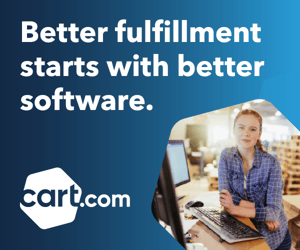Today's consumers expect seamless, intuitive and personalized shopping experiences, making it crucial for businesses to modernize their digital storefronts. The look and function of your ecommerce website can significantly affect business, either positively or negatively. According to a Storyblok survey, 60% of consumers say they abandon purchases due to poor user experience on websites. Prioritizing a mobile-friendly site, integrating advanced technologies like AI and AR, and unifying online and offline experiences are essential for capturing and retaining customers.
Why elevate your online ecommerce storefront presence
Elevating your online storefront presence is essential to staying competitive in a digital market. A more modern, user-friendly site enhances the customer experience and leads to higher engagement and conversion rates. When you update features and function, you differentiate your brand and can offer hyper-personalized experiences. This improved presence builds trust and loyalty, keys to long-term growth and success.
Here are five ways you can modernize your storefront:
1. Optimize for mobile
Today’s retail and B2B brands must optimize for mobile ecommerce. According to Pew Research, 91% of consumers make online purchases using their smartphones. This makes mobile-optimized storefronts essential for meeting customer expectations. Your website must be accessible, fast and user-friendly to support the shift to mobile-friendly commerce. A responsive storefront design allows your site to adapt quickly to different screen sizes, providing a consistent and intuitive experience whether the consumer uses a computer, smartphone or tablet. A responsive site requires:
- A layout that automatically adjusts to different devices, maintaining readability and ease of navigation.
- Optimizing images, streamlining navigation and ensuring fast load times to keep mobile users engaged.
Another tactic is to implement Accelerated Mobile Pages (AMP). AMP is a framework that supports faster loading times by simplifying HTML and CSS, which is beneficial for mobile users with slower internet connections. Faster load times improve user experience and boost your SEO rankings, helping more customers discover your store and increasing the likelihood of conversions.
2. Improve the user experience (UX) and user interface
A clean and intuitive design creates an effective digital storefront. Create a clutter-free, user-friendly interface to keep visitors engaged, especially in a world with shorter attention spans. The key elements of effective UX/UI design are easy navigation, clear readability and accessibility for all users. For example, you can guide customers through your site and reduce friction with a well-organized menu and straightforward calls to action, improving the potential for conversions.
Elevate the shopping experience further using personalization. Tailor product recommendations, content and offers to individual customers by leveraging data. A high level of personalization can boost engagement and drives conversion. For instance, showing personalized product suggestions based on past purchases or browsing history can significantly increase the chances of a sale.
Fast loading times are also crucial. Slow sites frustrate visitors and lead to higher bounce rates. Optimize your site speed by compressing images and caching browsers, as well as using content delivery networks (CDNs).
3. Integrate omnichannel capabilities
Meet modern customer expectations by integrating omnichannel capabilities into your digital storefront. Today’s consumers expect a frictionless experience across channels. The ability to transition seamlessly whether they’re browsing online, shopping in-store or interacting through social media is essential. Omnichannel retailing is necessary to provide a customer experience that drives loyalty and sales. For example, customers who can start their shopping journey online and complete it in-store, or vice versa, are more likely to stay engaged with your brand.
An omnichannel strategy requires unifying online and offline experiences. Use tactics such as offering buy online, pick up in-store (BOPIS) options or enabling in-store returns for online purchases create a cohesive experience that meets customers where they are. Tools like Customer Relationship Management (CRM) systems and Point of Sale (POS) integrations are essential; they allow consistent data flow and a unified view of the customer journey.
4. Leverage advanced technology
Incorporating advanced technology lets you compete in today’s ecommerce landscape. While there’s no complete replacement for live agents, you can amplify your customer service through personalized recommendations and instant support through chatbots. For example, AI-driven chatbots can answer customer queries 24/7, reducing response times and improving satisfaction. In addition, implementing machine learning technology that helps personalize recommendations can increase sales by presenting customers with products tailored to their preferences.
Augmented Reality (AR) and Virtual Reality (VR) are also gaining traction in online shopping. These technologies allow customers to visualize products in their environment before purchasing, increasing engagement and reducing returns. Brands like IKEA and Warby Parker have successfully implemented AR tools that let users virtually "try out" furniture or glasses, providing a more interactive shopping experience.
Voice search and smart assistants, such as Amazon Alexa and Google Assistant, are also reshaping ecommerce. You can optimize your digital storefront for voice search using natural language processing and focusing on long-tail keywords, making your products more easily discoverable through voice commands. This integration can improve accessibility and capture the growing segment of consumers who prefer hands-free shopping.
5. Strengthen security and trust
Experts suggest that 84% of retail organizations are at risk of cyberattack, making it the third-most targeted industry behind the financial services and healthcare sectors. Ecommerce businesses must strengthen digital security to prevent the loss of consumer trust. The rise of cyber threats like data breaches and phishing attacks has made cybersecurity a top priority. These security challenges risk financial loss and damage brand reputation. Implementing robust security measures, such as SSL certificates and regular security audits, is critical to protect sensitive customer information.
One critical component of safe shopping is a secure payment gateway. Best practices include using Payment Card Industry (PCI) compliant systems and offering multiple payment options, such as credit cards, PayPal and digital wallets, that customers recognize and trust.
Build trust through transparency as well. Create a trustworthy brand image with clear return policies, transparent shipping costs and honest customer reviews – display policies on your storefront in easily accessible areas, such as the footer or checkout pages.
Optimize your storefront with Cart.com
Ready to elevate your digital storefront? Cart.com’s ecommerce optimization services are designed to drive conversions with precision, enhancing your brand’s online presence and delivering a customer experience that inspires loyalty. From On-Site Content Marketing and SEO to Conversion Rate Optimization and UI/Visual Design, our data-driven approach ensures your site is optimized for success. We take the guesswork out of converting traffic by analyzing the customer journey and executing proven strategies that increase conversion rates and gross merchandise value (GMV). Whether you need seamless web development, strategic site merchandising or secure online payment management with our Merchant of Record services, Cart.com has the expertise to support your growth. Let’s talk about how we can help you optimize your ecommerce operations and build a world-class digital commerce site designed to scale.
Subscribe to our emails for the latest industry insights!
By entering your email, you agree to receive marketing emails from Cart.com







